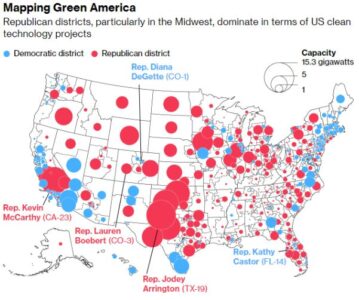Over the last few months Republicans in Congress have been writing strongly worded letters to each other about the various green energy subsidies created by the 2022 passage of the Inflation Reduction Act. In early March, 21 House Republicans urged Speaker Mike Johnson not to repeal the IRA in its entirety. About a month later four senators expressed a similar sentiment to congressional leaders. About a month after that, 38 other House Republicans urged the speaker to “fully repeal” the IRA.
We can understand each of these dueling letters – and members’ upcoming votes on IRA repeal – as the product of the way each of the signatories experiences bottom-up pressure from voters.[1] Members sign letters like these – or choose not to sign – based mostly on how the decision will affect the probability that they will be re-elected.
As mentioned many times before in this space, the primary reason that Congress is more ideologically polarized than the electorate is because most members represent safe seats: seats in which voters of one party or the other are so numerically dominant that the candidate of that party cannot lose the general election. These members protect their re-election prospects not by keeping their average constituent happy but rather by keeping the average primary voter happy. Primary voters, in turn, are much more negatively partisan and ideologically extreme than both the average voter and the average member of their own party.
Knowing all this, we can take a more educated look at who signed each of the two House letters? (We will ignore the Senate letter because only one of the signatories – Sen. Thom Tillis, R-NC – is up for re-election in 2026.) Do the signatories line up neatly along ideological lines? Do the signers of the anti-IRA letter represent safer GOP seats than the signers of the earlier pro-IRA letter? Does the amount of IRA funding that flowed (or was intended to flow) to their districts explain these decisions?
Helpful Data
IDEOLOGY: Political scientists measure the ideology of members of Congress on a left-right scale, and leading measure comes from a web site called Voteview.com.[2] That measure runs from -1 (most liberal) to +1 (most conservative). Today the average House Democrat sits at -.38 and the average House Republican at +.52; and there is no ideological overlap between the parties. Indeed, there has been no overlap for almost two decades, and the ideological gap between the most conservative Democrat and the most liberal Republican has grown since.
SAFE SEATS: The Cook Political Report is the leading measure of the “partisan lean” of a district. Cook’s 2025 PVI by district can be found here (though some of the data is behind a paywall).
IRA FUNDING: It has been widely reported that more IRA funding has gone to GOP districts than Democrat districts, though not every district has benefited from that statute’s largesse. The Trump Administration is in the process of trying to claw some of that money back. But as of August 2024 the consultancy E2 had matched IRA projects to congressional district, specifying number of projects, dollar values and number of jobs for each. That report can be found here.
[NOTE: None of the signatories to either letter appear among the top House recipients of money from the fossil fuel industry. See e.g., here and here.]
What do the data show?
This table lists the signatories to both House Republican letters, sorted by voteview ideology score – from most to least conservative. Signers of the pro-IRA letter are shaded green; signers of the anti-IRA letter are shaded red (click on table to enlarge).
Eyeballing the table a few things stand out. As a group, the signers of the pro-IRA letter are significantly more liberal than the signers of the anti-IRA letter. Recall that the average ideology score for House Republicans is +0.52. The average signer of the pro-IRA letter has a score of +0.34; the average signer of the anti-IRA letter has a score of +0.71. Not coincidentally, the anti-IRA letter signers represent districts that lean Republican by an average of more than 12 points, while the pro-IRA letter signers represent seats whose average partisan lean toward the GOP is less than 3 points. Neither group appears to have received significantly more IRA project funding or jobs than the other.
This is consistent with the idea that the signatories of the pro-IRA letter are protecting their re-election prospects by signaling their support for the IRA to their constituents, in the hope that it will matter in the relatively competitive general election they face in 2026. Those who signed the anti-IRA letter, in turn, protect their re-election prospects by pleasing their own party’s primary voters.
Still, there are some interesting exceptions in the table. Representatives Buddy Carter (GA-1), John Joyce (PA-13), and Erin Houchin (IN-9) are each more conservative than most of their Republican colleague, but each signed the pro-IRA letter. We can speculate they did so because their districts will gain jobs and money from IRA programs. Perhaps so, especially for Rep. Carter. Of the people listed in this table, no one’s district gained more projects as the result of the IRA, and the district ranks second in jobs and money gained from IRA programs.
On the other hand, several signers of the anti-IRA letter represent districts with much to gain from the IRA. The IRA was slated to bring 15 new projects, more than $10 billion dollars, and about 3,700 new jobs to the districts represented by Reps. Brecheen (OK-2), Spartz (IN-5), and Norman (SC-5). Yet all three endorsed “full repeal” of the IRA. Perhaps their choices are purely ideological. Norman and Brecheen have especially conservative voting records — even more conservative than Rep. Carter. And both represent seats that are safer than Carter’s.
But what about Rep. Spartz? Her seat, like Carter’s is rated R+8 by Cook Political Report. And like Carter her district stands to gain economically from the IRA. But she and Carter have staked out opposite positions on IRA repeal.
Spartz, Brecheen and Norman may be betting that flouting the president’s anti-green energy agenda carries more electoral risk for them than protecting the money and jobs the IRA is bringing to their constituents. Rep. Carter may simply be making the opposite bet. Or maybe Carter just believes that the IRA subsidies are good policy, and is willing to risk the president’s wrath. Regardless, it will be interesting to see if their positions affect their 2026 election campaigns. Will Spartz face risk in the general election for biting the hand that fed her district? Will Carter face a primary opponent who takes him to task splitting with the president on this issue?
The Fate of the IRA
For all of these reasons, the people to watch in this fight are the members who represent competitive districts. The things they have to do to protect their re-election prospects in the general election increase their electoral risk in a primary election. Some politicians navigate this difficult reality by signaling their “concern” about partisan legislation, while voting with their party when push comes to shove. (See e.g., Sen. Susan Collins, uses this technique so frequently that one news outlet called it “a meme.”)
As of this writing the House Ways and Means Committee is close to releasing the (budget) bill that will likely repeal some or all of the IRA energy subsidies. And in the last few days the signers of the March letter defending the IRA have been active. Rep. Jen Kiggans (R-VA) introduced a bill that would eliminate IRA tax credits for wind and solar generation, perhaps as a way to divert Republican energy away from broader IRA repeal. Several signatories of the March letter signed a May 9 letter to the Ways and Means Committee urging retention of the IRA “45X” tax credit for green manufacturing, and several are also co-sponsors of Kiggans’ bill. And one of the signatories to the Senate letter defending the IRA, Sen. Lisa Murkowski, aggressively defended carbon capture subsidies in the IRA in recent Senate hearings.
Assuming that the bill that emerges from the Ways and Means Committee repeals many but not all of the IRA subsidies, it will call the bluffs of each of the authors of these strongly worded letters. And it will reflect the GOP leadership’s best guesses about which GOP faction is making the more credible threat to break ranks if it doesn’t get its way. At that point, defenders of the IRA will have to decide which is the greater risk: defying a president and party that has turned against supporting the clean energy transition, or defying moderate voters in their districts who favor it.
My best guess is that they fear the former more than the latter, because the MAGA faction of the GOP has been willing to punish dissent than have the GOP voters who vote in general elections. But we shall see. — David Spence
———————
[1] See this earlier post examining the election results in a similar way.
[2] Lewis, Jeffrey B., Keith Poole, Howard Rosenthal, Adam Boche, Aaron Rudkin, and Luke Sonnet (2025). Voteview: Congressional Roll-Call Votes Database. https://voteview.com/





